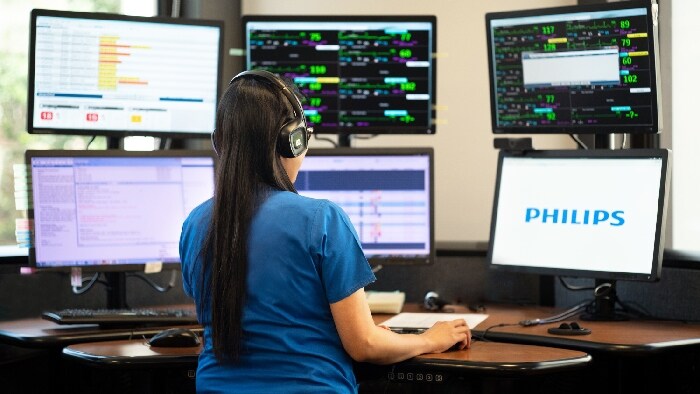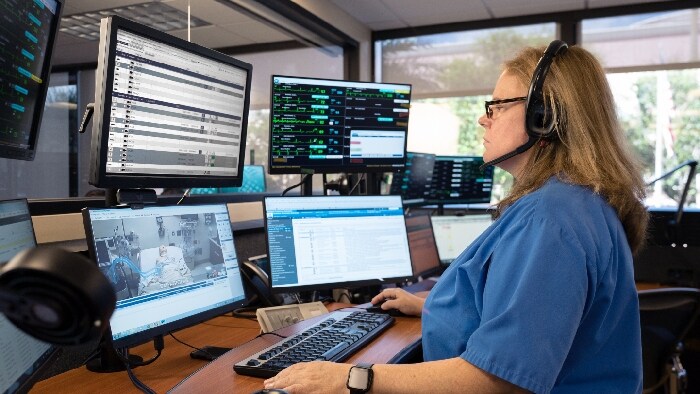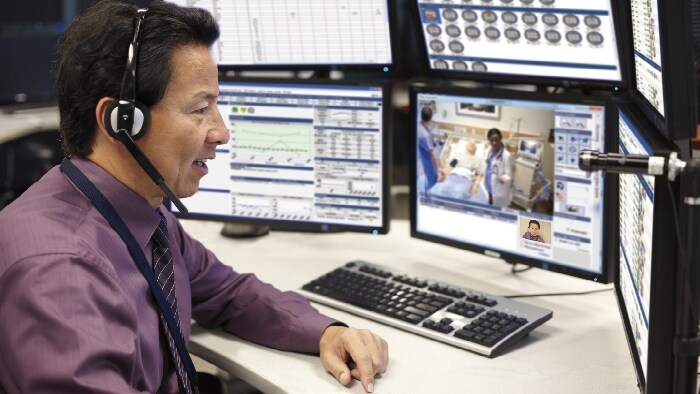Apr 14, 2021
The virtual hospital
What exactly is a virtual hospital? Hospital + Healthcare spoke with Matt Moran, ANZ Managing Director, to learn more.
HOW WOULD YOU DEFINE VIRTUAL CARE? Virtual Care is a proven model of care that brings together a centralised, senior team of clinicians and leverages technology to support patients both in and out of the hospital. The solution delivers need-to-know information to caregivers, empowering them to care for the patients who need it most, preventing deterioration before it happens. This care model challenges the current paradigm by allowing a small group of clinicians to support hundreds of bed-side clinicians and their patients, leading to better health and economic outcomes. In Australia, virtual healthcare technologies are on the rise. A change in the Medical Benefits Scheme (MBS) for telehealth arrangements has enabled widespread telehealth adoption. Until 2020[1], Australians overwhelmingly preferred face-to-face settings with healthcare providers, with only 0.1% being MBS virtual care attendances. During COVID-19, a survey [2]found that 62% of respondents found their telehealth experience was as good as or better than traditional in-person medical appointments. WHAT SCOPE IS THERE FOR VIRTUAL CARE TO IMPROVE PATIENT OUTCOMES? Virtual Care works on multiple fronts to improve patient outcomes. Apart from the clinical benefits associated with early clinical intervention, the ability to deliver virtual acute care unhindered by the challenges of distance in a country like Australia creates an enormous opportunity. For patients requiring longer-term continuous care, such as for those with chronic conditions, these solutions allow for treatment in the comfort and safety of their homes. Specific health and economic outcomes include:
WHAT ARE OTHER KEY BENEFITS OF THE TECHNOLOGY? Beyond improved patient outcomes, virtual care enhances patients’ experience by enabling health systems to deliver person centered care, improved safety and quality through process standardization, improve efficiency and enhances integrated care multidisciplinary team coordination4. The platforms underpinning these models of care are designed to allow for rapid efficient scale-up allowing for health systems to support multiple hospital systems and patients across vast geographies. For healthcare providers, this technology creates capacity by focusing teams on the patients who need them most to reduce mortality, maximise adherence to clinical best practices and shorten the length of stay. It also optimises existing capacity by having the right resources in the right place at the right time to remove bottlenecks within and across facilities. Philips has successfully rolled out a remote Intensive Care Unit between US-based Emory Healthcare5 based at the Royal Perth Hospital in Western Australia. This program sees critical care physicians (intensivists) and acute care nurse experts provide medical care to patients in the US from their base at Royal Perth Hospital using Philips’ remote intensive care unit monitoring technology. WHAT ARE THE BARRIERS TO UPTAKE OF VIRTUAL CARE SOLUTIONS? There are a number of internal and external barriers that are slowing the widespread adoption of virtual hospital technologies. The largest barriers to uptake is however the availability of suitable re-imbursement models to justify investment and sustainability. The current hospital re-imbursement models of activity-based funding tend to support funding for intervention rather than prevention that inhibits rapid scale-up of these solutions. Other contributing factors include: COVID-19 has seen a rapid increase in virtual healthcare technology adoption; however, now is the time to ensure we maintain momentum and maximise the opportunity of virtual healthcare. The 2019 edition of the Philips Future Health Index report explored the impact of digital health technology on healthcare professionals and patients and detailed key barriers and solutions to virtual care adoption locally. Key findings from the 2019 report include:
A CLOSER LOOK AT A VIRTUAL HOSPITAL Philips has delivered virtual hospital services to East Metropolitan health services (EMHS) to improve patient care and proactively detect the risk of patient deterioration. The clinical command centre is a cornerstone of EMHS’s Health in a Virtual Environment (HIVE) programme responsible for driving a hub and spoke model of care that utilises machine learning and predictive analytics to reduce length of stay as well as complications avoidable transfers and mortality. Based at the Royal Perth Hospital, the Clinical Command Centre overseas inpatients in patients in step-down units and higher acuity wards. The technology will provide a virtual safety net of specialist support for over 100 beds over the next five years. The Clinical Command Centre is an example of how technology can be integrated within the healthcare sector to deliver improved patient outcomes and staff support. In Clinical Command Centres across the world Phillips has leveraged its monitoring, machine learning and advanced analytics to drive reduced mortality, reduced complications and reduced lengths of stay. This technology has historically improved patient experience and reduced provider turnover on multiple fronts including a 26%7 reduction inpatient mortality a 30%8 reduction in length of stay and help 15%9 of patients be discharged home faster. Phillips managing director Australia and New Zealand Matt Moran said, “In working with the East Metropolitan Health Service to develop the HIVE programme we have created a virtual hospital solution capable of predicting patient deterioration and to help identify and prioritise patients most at risk for earlier interventions.” “This clinical command centre will help EMHS unlock gains an efficiencies and drive innovations that helped deliver on the quadruple aim; enhancing the patient experience, improving health outcomes, lowering the cost of care and improving the work life of care providers.” At the launch of the HIVE project at EMHS Western Australian Deputy Premier and Health Minister Hon Roger Cook said, “The McGowan government has a strong commitment to encouraging investment in innovation to improve the future health of all Western Australians. The Sustainable Health Review highlighted the need to invest in digital healthcare to transform and improve the quality of care for Western Australians and the HIVE is a great example of that investment in action.” “The HIVE will revolutionise the way we delivered healthcare in WA and will also provide ongoing opportunities for research involving artificial intelligence and data analytics to ensure WA researchers are at the forefront. The HIVE also represents a major opportunity for WA researchers and innovators to become world leaders in the development of biotechnology and AI assisted healthcare delivery.” Moran concluded, “The advanced technologies behind our Clinical Command Centre reference sites have a proven track record and are constantly improving however achieving value-based outcomes requires clinical transformation - and that is precisely what has driven the success of the Philips Clinical Command Centre globally of over the last 20 years. Our program combines people technology and process to provide measurable predictable and sustainable outcomes.” VIRTUAL HOSPITAL EXTENDS TO SUPPORT COVID-19 PATIENTS Queensland’s West Morton health has expanded its innovative virtual hospital programme to support COVID-19 patients recovering at home. Developed by Phillips and introduced in 2016, MeCare - Mobile Enabled Care - allows chronically ill patients to track their daily health targets, manage symptoms and use video conferencing to connect with a clinical team each day. West Morton and Phillips expanded their partnership to safely care for more people in response to the COVID-19 pandemic and reduced demand for hospital services. West Morton Health’s Community and Rural Services Executive Director Melinda Parcell said the MeCare model was adapted for COVID-19 patients with milder symptoms. “West Morton Health has expanded its hospital capacity as a part of its response to the COVID-19 outbreak, but we have also considered how we can use existing technology and innovation to provide safe care within the community setting. It means people can receive the care they need in the comfort of their own homes and we are also eliminating the risk of transmission in the hospital setting, where other vulnerable people may be receiving care.” Depending on their acuity and care needs COVID-19 patients can be cared for at home under either the moderate or ‘lite’ model, moderate model patients are also given tablets and health devices so that they can measure their temperature, blood pressure and oxygen saturation levels and respond to regular health surveys to track their health progress. Others who require less supervision can use their own mobile devices to receive remote support by a Phillips enterprise remote patient monitoring platform (eCareCoordinator). The health information recorded on each of these devices is monitored by West Morton Health’s virtual health care team, which can provide timely intervention through phone calls video conferencing and in-home visits as needed. Moran said well-designed virtual hospital programmes enabled health systems to best leverage clinical resource is to ensure patient care was not compromised. “In partnership with West Moreton Health we are proud of the virtual capability of maker now being leveraged to manage COVID-19 patients,” he said. “Supported by Philips technology, a small group of highly trained West Morton clinicians are able to deliver care to a large amount of people in the community. “This is possible because these clinicians are able to provide timely intervention to only those participants needing care while smart clinical decision supporting tools highlight those at greatest need. Using the right technology in at the most appropriate ratio of clinicians to patients is a crucial success factor at a time when resources must be conserved.” This interview was first published in the Autumn 2021 issue of Hospital and Healthcare Magazine
About Royal Philips
Royal Philips (NYSE: PHG, AEX: PHIA) is a leading health technology company focused on improving people's health and well-being, and enabling better outcomes across the health continuum – from healthy living and prevention, to diagnosis, treatment and home care. Philips leverages advanced technology and deep clinical and consumer insights to deliver integrated solutions. Headquartered in the Netherlands, the company is a leader in diagnostic imaging, image-guided therapy, patient monitoring and health informatics, as well as in consumer health and home care. Philips generated 2020 sales of EUR 19.5 billion and employs approximately 82,000 employees with sales and services in more than 100 countries. News about Philips can be found at www.philips.com/newscenter.





